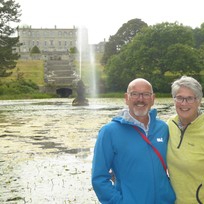( Overview
/ Two Bullocks on a Boat in Eire
The joys of rafting. The man on the inside boat wanted to leave before the man on the outside. Kevin went to help with the process of swapping. The Dutch sailor on the outside wasn’t going to be rushed, so it took a while.
There was a constant stream of tenders bringing passengers to coaches on shore. A few stayed locally, but most were taken into Waterford.
The pathway was created by the workers who built the harbour in the 1820s so they could walk to and from their communities. The beginning of the walk, The Flat Rocks, was originally a quarry, from which the stone, known locally as pudding stone, was used to construct the harbour.
‘Extreme’ angling seems popular; some people scrambling down the cliff face, rods in hand, to stand on the edge of the rocks.
Anglers are not the first to venture down the cliffs. During the period of the Penal Laws in the 17th and 18th centuries, when it was forbidden to celebrate Mass, Catholics would climb down to the Bishop’s Cave to worship, and the priest could arrive and return by sea without being seen.





















 Sign in with Apple
Sign in with Apple  Log in with Facebook
Log in with Facebook